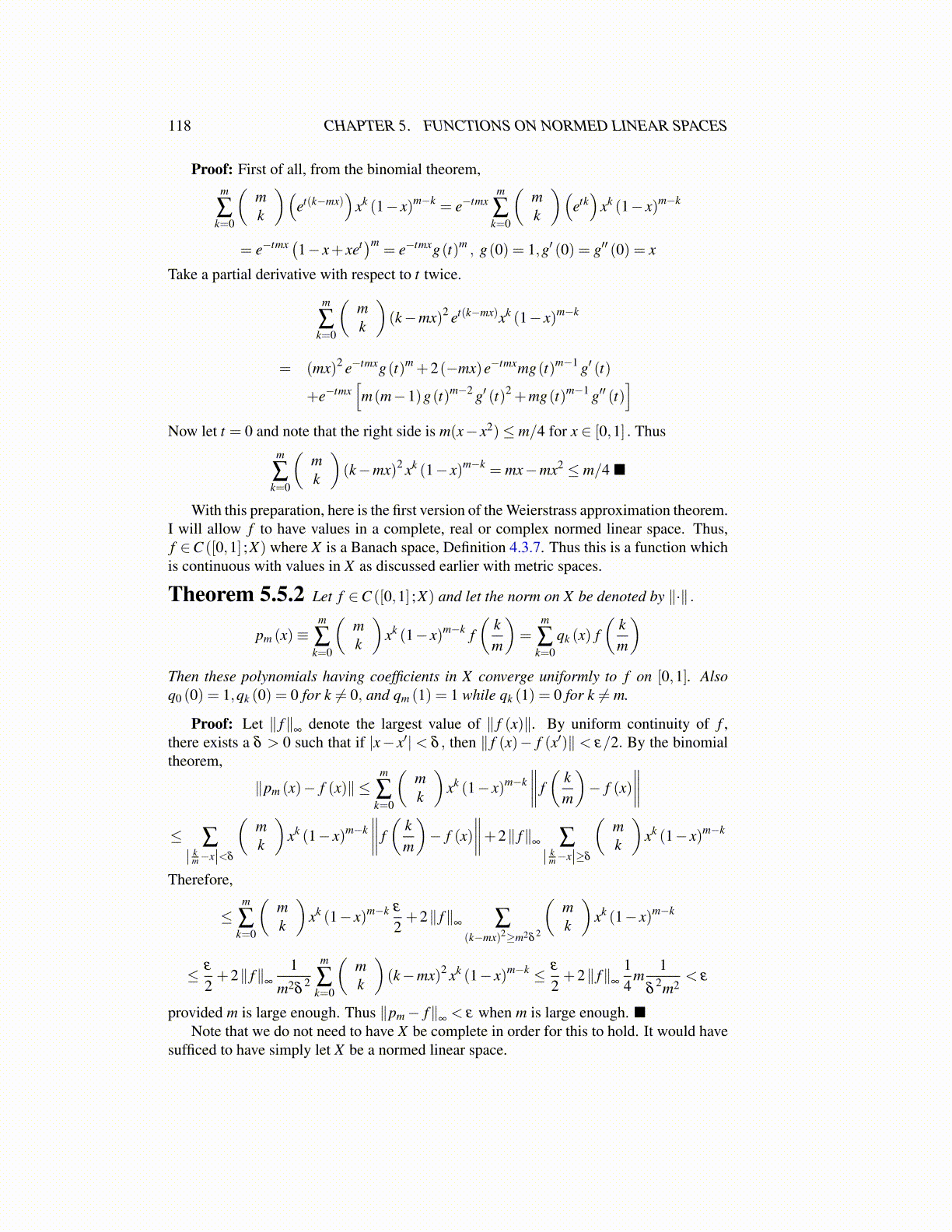
118 CHAPTER 5. FUNCTIONS ON NORMED LINEAR SPACES
Proof: First of all, from the binomial theorem,m
∑k=0
(mk
)(et(k−mx)
)xk (1− x)m−k = e−tmx
m
∑k=0
(mk
)(etk)
xk (1− x)m−k
= e−tmx (1− x+ xet)m= e−tmxg(t)m , g(0) = 1,g′ (0) = g′′ (0) = x
Take a partial derivative with respect to t twice.
m
∑k=0
(mk
)(k−mx)2 et(k−mx)xk (1− x)m−k
= (mx)2 e−tmxg(t)m +2(−mx)e−tmxmg(t)m−1 g′ (t)
+e−tmx[m(m−1)g(t)m−2 g′ (t)2 +mg(t)m−1 g′′ (t)
]Now let t = 0 and note that the right side is m(x− x2)≤ m/4 for x ∈ [0,1] . Thus
m
∑k=0
(mk
)(k−mx)2 xk (1− x)m−k = mx−mx2 ≤ m/4 ■
With this preparation, here is the first version of the Weierstrass approximation theorem.I will allow f to have values in a complete, real or complex normed linear space. Thus,f ∈C ([0,1] ;X) where X is a Banach space, Definition 4.3.7. Thus this is a function whichis continuous with values in X as discussed earlier with metric spaces.
Theorem 5.5.2 Let f ∈C ([0,1] ;X) and let the norm on X be denoted by ∥·∥ .
pm (x)≡m
∑k=0
(mk
)xk (1− x)m−k f
(km
)=
m
∑k=0
qk (x) f(
km
)Then these polynomials having coefficients in X converge uniformly to f on [0,1]. Alsoq0 (0) = 1,qk (0) = 0 for k ̸= 0, and qm (1) = 1 while qk (1) = 0 for k ̸= m.
Proof: Let ∥ f∥∞
denote the largest value of ∥ f (x)∥. By uniform continuity of f ,there exists a δ > 0 such that if |x− x′| < δ , then ∥ f (x)− f (x′)∥ < ε/2. By the binomialtheorem,
∥pm (x)− f (x)∥ ≤m
∑k=0
(mk
)xk (1− x)m−k
∥∥∥∥ f(
km
)− f (x)
∥∥∥∥≤ ∑| k
m−x|<δ
(mk
)xk (1− x)m−k
∥∥∥∥ f(
km
)− f (x)
∥∥∥∥+2∥ f∥∞ ∑| k
m−x|≥δ
(mk
)xk (1− x)m−k
Therefore,
≤m
∑k=0
(mk
)xk (1− x)m−k ε
2+2∥ f∥
∞ ∑(k−mx)2≥m2δ
2
(mk
)xk (1− x)m−k
≤ ε
2+2∥ f∥
∞
1
m2δ2
m
∑k=0
(mk
)(k−mx)2 xk (1− x)m−k ≤ ε
2+2∥ f∥
∞
14
m1
δ2m2
< ε
provided m is large enough. Thus ∥pm− f∥∞< ε when m is large enough. ■
Note that we do not need to have X be complete in order for this to hold. It would havesufficed to have simply let X be a normed linear space.